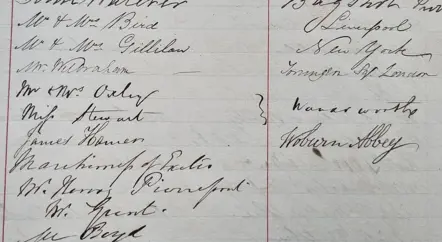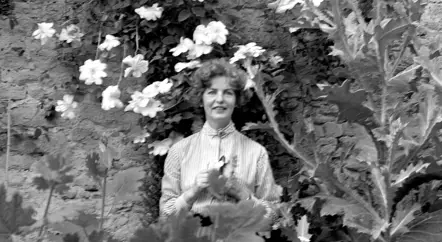Among the many changes carried out at Chatsworth by the 6th Duke of Devonshire, was the modernisation of a suite of guest rooms on the first floor of the house in the late 1820's.
The Wellington Bedroom, Wellington Dressing Room, Leicester Bedroom, and Queen of Scots Dressing Room were reconfigured and redecorated by the Duke and he commissioned furniture from the most fashionable makers of the time, such as Crace and Seddon.
When it came to choosing wallpaper, surprisingly, the Duke rejected the popular style set by his friend King George IV at the Pavilion in Brighton, and instead chose a series of hand-blocked and painted 'bird and branch' wallpapers, believed to have been crafted in Guangzhou (formerly Canton) in Southern China around 1790.
The papers are some of the most frequently admired decorative objects at Chatsworth and feature native species of plants, birds and butterflies. Although stylised, the feather colour, shape and texture of each are well observed.
It's clear the Duke had a fondness for Chinese papers; there is a different design in each of the four rooms and a fifth design has been used to decorate two screens. In 1844, he describes Chinese papers used in his home in Kemp Town, Brighton, with admiration:
'The Drawing Room has a charming paper that was once beautiful and still looks well, though the silvery trees have become shaded with black: it is the gayest of all decorations. Porcelain birds, on brackets of red scagliola, project from the wall, and seem to have emerged from the paper.'
Wallpapers such as these were produced exclusively for the export market and became increasingly popular in England in the 1700s. It's not known whether the Duke reused wallpapers he had elsewhere, if they were gifted, or if they were unused 'stock' purchased from a vendor as, at present, there is no record of the purchase in the Duke's receipts stored in the archives.
images: 1. the Wellington Bedroom, 2. the Wellington Bedroom (credit Matthew Bullen), 3. the Leicester Bedroom
Urgent conservation required
The conservation team identified that the wallpapers needed urgent restoration as, over the hundreds of years since their hanging, they had been damaged by water leaks, damp, and smoke from coal fires.
In 2020, Chatsworth House Trust undertook conservation on the green bamboo wallpaper in the Queen of Scots Dressing Room. Last year, we were able to bring specialist conservators back to complete the restoration, focusing on the papers in the Wellington and Leicester guest bedrooms.
At first glance the papers, sited in rooms dimly lit to preserve the historic textile furnishings, appeared to be in good condition, the colours were bright and the motifs well defined. However, on closer inspection, it was evident that past water ingress had left marks and stains and some of the motifs were partially and in some cases fully detached.
Of more concern were areas where the paper was sagging. This was possibly due to a combination of moisture ingress and extensive “cutting-in”; where a sharp tool had been used to open up bubbles or raised areas. These areas had been covered with green paint in an attempt to disguise the damage, however, the paint had made the paper stiff and uneven. Once the papers had begun to lift, their multiple layers of lining exacerbated the problems and there was some urgency in completing conservation before the paper fully detached from the wall.
Signs of damage in the Wellington Bedroom
New discoveries
Work such as this sometimes enables us to discover new information about the people who lived and breathed in these historic spaces before us (a great example is the discovery of chocolate wrappers behind the Mortlake Tapestries). As furniture and furnishings were removed to allow better access, we were able to uncover and photograph Chinese characters which appear on the bottom edge of each of the strips of paper.
Translated, the characters are a series of numbers presumably used to aid paperhanging, however as the numbers don’t form a sequence they do not appear to have been followed. We'd love to know if English, and other European paper hangers, understood these symbols as numbers, and if the sequence has ever been followed in any other historic property in the country.
Chinese symbols uncovered on the papers
Beauty and history preserved for future generations
The restorers spent weeks carefully cleaning, re-adhering and re-attaching loose and detached elements. Sagging sections of the papers were relined and adhered, and paint was sensitively and accurately retouched.
The restoration preserves the beauty and integrity of these historic wallpapers and ensures they can be admired, and studied, for many more years to come.
With your support, we can do so much more
The restoration of the Chinese wallpapers by Chatsworth House Trust was only possible thanks to the income generated from visitor admission, Gift Aid, donations and our Friends and Patrons membership schemes.
Chatsworth House Trust (registered charity 511149) is dedicated to looking after the house, collections, garden, parkland and woodlands for the benefit of everyone, and all income goes directly to the charity to be reinvested in the upkeep, preservation and improvement of Chatsworth, and our learning programmes.
Learn more about our charity and our membership schemes, or make an online donation to support future projects using the links below.
About Chatsworth House Trust
Chatsworth House Trust is a registered charity established in 1981 to improve and maintain the house, collections, garden, woodlands and park for the benefit of everyone.
Support our Cascade Campaign
The Cascade has been delighting visitors to Chatsworth since 1696 but is now in need of urgent repair. Learn more about our fundraising campaign 'Celebrating the Cascade'.
Donate online
If you can, support us by making a one-off or regular donation to the Chatsworth House Trust charity online.
Chatsworth Friends
Support the work of the charity while benefitting from unlimited visits, free tickets to events and discounts on shopping, dining and stays.
Gift Aid
When you use Gift Aid, the government gives an extra 25% on top of your kind donation, in lieu of tax you have already paid. All of this money goes directly to Chatsworth House Trust.
Patrons of Chatsworth
Patrons play a vital role in supporting the long-term stewardship of Chatsworth and enjoy exclusive access to the collections and curatorial team via special events.





